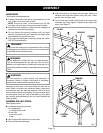
Page 18
OPERATION
AVOIDING INJURY
n Make sure saw is level and does not rock. Saw should
always be on a firm, level surface with plenty of room for
handling and properly supporting the workpiece.
n Bolt saw to the support surface to prevent slipping,
walking or sliding during operations like cutting long,
heavy boards.
n Turn saw off, remove switch key, and unplug cord from
the power source before moving the saw.
n Do not remove jammed cutoff pieces until blade has come
to a full and complete stop.
n Choose the right size and style blade for the material and
type of cut you plan to do.
n Make sure that the blade teeth point down toward the saw
table, that the blade guides, thrust bearings, and blade
tension are properly adjusted, that the blade guide knob
is tight, and that no parts have excessive play.
n To avoid accidental blade contact, minimize blade
breakage, and provide maximum blade support, always
adjust the blade guide assembly to just clear the
workpiece.
n Use only recommended accessories.
n With the exception of the workpiece and related support
devices, clear everything off the saw table before turning
the saw on.
n Properly support round materials such as dowel rods or
tubing because they have a tendency to roll during a cut
causing the blade to “bite”. To avoid this, always use a
“V” block or clamp workpiece to a miter gauge.
n Before removing loose pieces from the saw table, turn
saw off and wait for all moving parts to stop.
LOCKING THE SWITCH
See Figure 15.
n Place the switch in the OFF (O) position. Wait until the
saw has come to a full and complete stop.
n Remove the switch key from the switch assembly. Store
key in safe place.
BEFORE LEAVING THE SAW
n Place the switch in the OFF (O) position. Wait until the
saw has come to a full and complete stop.
n Remove the switch key from the switch assembly. Store
key in safe place.
n Unplug the saw from the power source.
n Make workshop childproof.
n Lock the shop.
SAW
TABLE
BEVEL LOCK
KNOB
SCALE
INDICATOR
OFF
SWITCH
KEY
ON
TILTING THE TABLE
See Figure 16.
n Loosen the bevel lock handle slightly.
n Turn the bevel adjustment knob, tilting the saw table
toward the front of the saw housing until it reaches the
desired angle.
n Using the scale indicator, check angle markings.
n Retighten the bevel lock knob to hold saw table securely
in place.
Fig. 15
Fig. 16
BEVEL ADJUST-
MENT KNOB


















